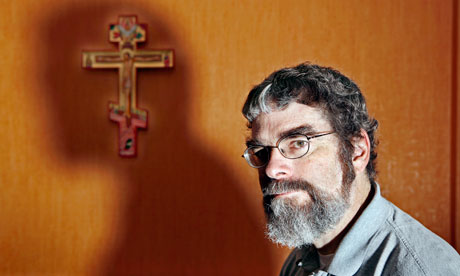Pope’s Astronomer Says He Would Baptise an Alien
September 21st, 2010Why is the pace picking up?
Via: Guardian:
Aliens might have souls and could choose to be baptised if humans ever met them, a Vatican scientist said today. The official also dismissed intelligent design as “bad theology” that had been “hijacked” by American creationist fundamentalists.
Guy Consolmagno, who is one of the pope’s astronomers, said he would be “delighted” if intelligent life was found among the stars. “But the odds of us finding it, of it being intelligent and us being able to communicate with it – when you add them up it’s probably not a practical question.”
Speaking ahead of a talk at the British Science Festival in Birmingham tomorrow, he said that the traditional definition of a soul was to have intelligence, free will, freedom to love and freedom to make decisions. “Any entity – no matter how many tentacles it has – has a soul.” Would he baptise an alien? “Only if they asked.”
Consolmagno, who became interested in science through reading science fiction, said that the Vatican was well aware of the latest goings-on in scientific research. “You’d be surprised,” he said.
2 Responses to “Pope’s Astronomer Says He Would Baptise an Alien”
 Guy Consolmagno, one of the pope's astronomers, said he would be 'delighted' if intelligent life was found among the stars. Photograph: David Sillitoe/Guardian
Guy Consolmagno, one of the pope's astronomers, said he would be 'delighted' if intelligent life was found among the stars. Photograph: David Sillitoe/Guardian- Worlds Apart (with Martha W. Schaefer, Prentice Hall, 1993)
- Turn Left at Orion (with Dan M. Davis, Cambridge University Press, 1995)
- The Way to the Dwelling of Light (University of Notre Dame Press, 1998)
- Brother Astronomer, Adventures of a Vatican Scientist (McGraw Hill, 2000) Review
- Intelligent Life in the Universe? Catholic belief and the search for extraterrestrial intelligent life (Catholic Truth Society, 2005)
- God's Mechanics: How Scientists and Engineers Make Sense of Religion (Jossey-Bass, 2007)
- The Heavens Proclaim: Astronomy and the Vatican (with S.J., Vatican Observatory Publications, 2009)
- Personal website
- Blog
- The Friends of Guy Consolmagno
- Vatican Observatory website
- "Brother Guy Consolmagno: Knocking on heaven's door", profile by John Crace in The Guardian, 9 May 2006.
- Interview with Guy Consolmagno at Astrobiology Magazine (2004).
- Interview with Guy Consolmagno from Grace Cathedral's The Forum. A streaming video is also available.
- Guy Consolmagno's BBC radio series 'A Brief History Of The End Of Everything'

Popes New Telescope

Courtesy of Lucifer: This image depicts a stellar nursery in the Milky Way about 8,000 light years from Earth. Such clouds are typically opaque to visible light, but infrared light can penetrate them. The Lucifer instrument helps telescopes see that light. The E and N signify east and north. Source: Anna Pasquali/via University of Arizona
(Notice that the direction arrows for east and north resemble horns - M. Hoffman).
The instrument is chilled to -213 Celsius, about -351 F, to allow for near-infrared observations. That wavelength is important for understanding star and planet formation, as well as observing very distant and very young galaxies. Lucifer has three interchangeable cameras for imaging and spectroscopy in different resolutions. It has a large field of view and high-res capabilities, which allow a wide range of observations.
Lucifer is part of the Large Binocular Telescope, which happens to be right next to the Vatican Observatory on Mt. Graham in Tucson. That's right, the Vatican has an observatory in Arizona, manned by Jesuit astronomers. Now its next-door neighbor is named for the Devil.
Scientists at five German universities designed the instrument, and they came up with the name, according to Daniel Stolte, a spokesman for the University of Arizona. Stolte -- who is German -- explained that the team was tossing around names, looking for an acronym that would fit all the technical terms.
"In Germany, they wouldn't have the same hesitation that Americans would have, since it's a very secular country," he said. "I may be completely off, but that's just my hunch -- for us Germans, Lucifer just sounds cool. It's more historical than emotional." No matter your religion, the photos are certainly cool.
End quote (emphasis supplied).
Interview with Brother Guy Consolmagno
 12 May 2004 ... Guy Consolmagno: I do meteorite research. I'm also a planetary scientist, ... Vatican Advanced Technology Telescope (VATT) Credit: VATT/Arizona ... Presented in November 1996 to Pope John Paul II at a conference on galaxy formation. .... which has fit in with new ideas that the asteroids are not big ...
12 May 2004 ... Guy Consolmagno: I do meteorite research. I'm also a planetary scientist, ... Vatican Advanced Technology Telescope (VATT) Credit: VATT/Arizona ... Presented in November 1996 to Pope John Paul II at a conference on galaxy formation. .... which has fit in with new ideas that the asteroids are not big ...
www.astrobio.net/.../interview-with-brother-guy-consolmagno - Cached - Similar» The Pope's Astronomer — A Surprising Interview With Brother Guy ...











September 21st, 2010 at 6:30 am
Because there’s not much time left?
September 21st, 2010 at 1:21 pm
Oh… Maybe they’re gonna lift the veil…